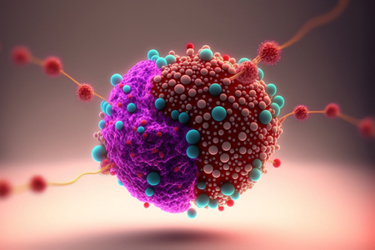Emerging RNA Delivery Strategies For Solid Tumor Oncology
By Jyotsna Jajula, research assistant, Wayne State University

RNA-based therapeutics, including messenger RNA (mRNA), small interfering RNA (siRNA), and self-amplifying RNA (saRNA), are transforming the landscape of cancer treatment by enabling gene silencing, immune activation, and protein replacement.¹ These platforms offer the potential to correct disease-causing mutations, modulate immune responses, or deliver tumor-specific cytotoxic instructions with unprecedented precision. However, their successful translation into clinical oncology, particularly for solid tumors, remains constrained by delivery limitations.
Unlike hematologic malignancies, solid tumors present a range of biophysical and immunological barriers that impede the delivery of RNA payloads to the intended site of action. These include poor vascularization, abnormal interstitial pressure, and dense extracellular matrices, which restrict both nanoparticle accumulation and uniform tissue penetration.
Lipid nanoparticles (LNPs) have demonstrated robust efficacy in liver-targeted applications;² however, their biodistribution profile is heavily skewed toward hepatic uptake, making them suboptimal for tumor types outside the liver. As a result, many promising RNA therapies fail to achieve therapeutic concentrations at solid tumor sites.
Overcoming these delivery barriers is critical to unlocking the full potential of RNA therapeutics in solid tumor oncology. Future progress will require “smarter,” tumor-adaptive delivery platforms capable of navigating the hostile tumor microenvironment.
Barriers In The Tumor Microenvironment
Solid tumors present a uniquely hostile environment for RNA-based therapeutics. The tumor microenvironment (TME) encompasses a variety of interconnected physical, biochemical, and immunological barriers that collectively impair nanoparticle accumulation, tissue penetration, cellular uptake, and intracellular RNA release.
These include:
- Dense extracellular matrix (ECM): The ECM, composed predominantly of collagen, fibronectin, and glycoproteins, forms a rigid scaffold that restricts the diffusion of RNA-loaded nanoparticles and impedes uniform distribution throughout the tumor mass.³
- Abnormal vasculature: Tumor-associated blood vessels are often poorly organized, tortuous, and leaky, leading to heterogeneous perfusion, insufficient oxygenation, and inefficient delivery of systemically administered therapeutics.⁴
- Elevated interstitial fluid pressure (IFP): Dysregulated lymphatic drainage and vascular leakage contribute to elevated IFP, which opposes the convective transport of nanoparticles and limits their ability to penetrate deeply into tumor tissue. For instance, LNPs administered systemically often fail to penetrate beyond perivascular regions in solid tumors due to ECM density and elevated IFP.
- Hypoxia and acidic pH: Hypoxic regions and low extracellular pH, common features of solid tumors, can destabilize RNA molecules and impair endosomal escape, reducing cytoplasmic release and translational efficiency.⁵
- Immunosuppressive signaling: The TME often contains regulatory T cells (Tregs), myeloid-derived suppressor cells (MDSCs), and immunosuppressive cytokines such as IL-10 and TGF-β, which dampen RNA-mediated immune activation and reduce the efficacy of immunotherapeutic strategies.
- Tumor heterogeneity: Spatial and temporal variability in ECM density, receptor expression, and immune cell infiltration, within and across tumors, further complicates the design of universally effective RNA delivery systems.
Together, these features underscore the complexity of the TME and highlight the urgent need for tumor-adaptive RNA delivery platforms capable of overcoming its multifactorial barriers.
Tumor-Targeted RNA Delivery Strategies
To address the multifactorial delivery barriers presented by solid tumors, next-generation RNA delivery systems are increasingly engineered with tumor-targeting features that enhance selective accumulation, cellular uptake, and intracellular RNA release. The following advances aim to improve the therapeutic index while minimizing off-target effects:
- Ligand-directed lipid nanoparticles (LNPs): Surface-functionalized LNPs incorporating tumor-homing ligands, such as monoclonal antibodies, peptides, or aptamers, enable receptor-mediated endocytosis by selectively binding to overexpressed surface markers on cancer cells (e.g., folate receptor, HER2, integrins).⁶ This target approach enhances tumor localization and promotes efficient intracellular delivery.
- Virus-like particles (VLPs): VLPs mimic the structure of native viruses using self-assembled capsid proteins to encapsulate RNA but lack viral genetic material. Their natural tropism for cellular entry enhances endosomal uptake and cytosolic delivery, and they can be engineered to engage tumor-specific receptors,⁷ offering an attractive balance of safety and efficiency.
- Stimuli-responsive carriers: These systems are designed to release their RNA cargo in response to tumor-specific cues such as acidic pH, elevated matrix metalloproteinase (MMP) activity, or intracellular redox gradients. This conditional activation improves spatial control over payload release, limits off-target expression, and enhances therapeutic precision.⁸
- Multifunctional nanoparticles: Some delivery platforms integrate multiple design elements. These include, for example, PEGylation to extend circulation time, targeting ligands for active tumor homing, and pH-sensitive linkers for endosomal escape. These modular architectures are particularly promising for navigating the heterogeneous and dynamic landscape of solid tumors.
By tailoring delivery vehicles to exploit tumor-specific features, these emerging strategies help to close the translational gap between promising RNA formulations and in vivo therapeutic efficacy in solid tumor models.
Translational And Regulatory Challenges
Despite promising results in preclinical models, the clinical translation of tumor-targeted RNA delivery systems faces several critical hurdles related to manufacturing complexity, safety assessment, and regulatory alignment. These challenges span both the technical and operational aspects of RNA therapeutic development, including:
- Manufacturing complexity: Multifunctional nanoparticles, particularly those incorporating targeting ligands, pH-sensitive linkers, or stimuli-responsive elements, often require multistep synthesis, purification, and characterization processes. These added complexities increase batch-to-batch variability and pose significant challenges to scaling under GMP conditions, ultimately impacting clinical and commercial viability.⁹
- Reproducibility and stability: RNA carriers must consistently maintain encapsulation efficiency, particle uniformity, and functional integrity throughout formulation, storage, and administration. Variability in these attributes can compromise both therapeutic efficacy and patient safety.
- Immunogenicity and safety risks: Many patients with advanced solid tumors are immunocompromised, increasing the risk of adverse immune responses. Introducing novel materials, such as viral capsids, synthetic polymers, or immune-stimulating ligands, can trigger cytokine release, unintended immune activation, or off-target effects.¹⁰ Long-term safety data remain limited for many of these platforms.
- Lack of standardized metrics: Unlike small molecules or monoclonal antibodies, RNA therapeutics lack harmonized criteria for assessing tumor-targeted delivery efficiency, biodistribution, pharmacokinetics, and intracellular release. Platform variability complicates cross-study comparisons and slows regulatory consensus.
- Regulatory ambiguity: Global regulatory agencies are still evolving their guidance on RNA-delivery combinations, especially for oncology applications. IND applications increasingly require comprehensive data sets, including advanced biodistribution studies, single-cell analytics, immune profiling, and long-term toxicity assessments.¹¹
Addressing these challenges will require not only robust platform optimization but also early and transparent engagement with regulatory bodies. Defining clear quality standards, safety benchmarks, and analytical requirements will be essential to advancing RNA delivery systems from bench to bedside in oncology.
Future Directions
To unlock the full potential of RNA-based therapeutics in solid tumors, future delivery platforms must prioritize precision, modularity, and adaptability, key features needed to overcome the heterogeneity and complexity of the tumor microenvironment.
Modular design systems are enabling researchers to rapidly interchange components, such as RNA cargo, lipid chemistry, or targeting ligands, to suit the unique demands of different tumor types and microenvironments.¹² This plug-and-play approach supports faster iteration, platform scalability, and patient-specific customization.
Biomarker-guided delivery is emerging as a powerful strategy to enhance specificity. By using tumor-associated surface markers (e.g., folate receptor, HER2, integrins) as molecular “ZIP codes,” nanoparticles can be functionalized to selectively deliver RNA payloads to cancer cells while sparing healthy tissue.
Localized administration routes, such as intratumoral or peritumoral injection, can circumvent systemic clearance, reduce off-target exposure, and boost payload concentrations at the tumor site. This is particularly advantageous in accessible tumors like melanoma, head and neck cancer, or sarcoma.
Combination therapies involving RNA therapeutics alongside checkpoint inhibitors, radiation, or chemotherapy may yield synergistic benefits, improving immune activation, overcoming resistance, or sensitizing tumors to treatment.¹³ These approaches are already being evaluated in early-phase trials.
Cross-disciplinary innovation, merging advances in materials science, immunology, bioinformatics, and AI, is accelerating the rational design of next-generation RNA delivery platforms. Predictive modeling, high-throughput screening, and machine learning algorithms are now guiding the selection of optimal formulations for each tumor context.
Together, these innovations signal a shift away from static, one-size-fits-all formulations toward tumor-adaptive delivery technologies. By aligning platform design with tumor biology, future RNA therapeutics will be better positioned to achieve clinical success in solid tumor oncology.
Conclusion
Solid tumors present distinct biophysical, immunological, and regulatory barriers that limit the effectiveness of RNA-based therapeutics. While current platforms, such as lipid nanoparticles, have demonstrated success in hepatic and vaccine applications, their limitations in tumor targeting underscore the urgent need for more sophisticated, tumor-adaptive delivery systems.
Emerging strategies, including ligand-directed carriers, stimuli-responsive platforms, localized administration, and combination therapies, are beginning to address these challenges. Continued progress will depend on integrating insights from tumor biology, materials science, and translational research, as well as on establishing clear regulatory frameworks for complex RNA-delivery platforms.
Closing the delivery gap will be key to realizing the full therapeutic potential of RNA in solid tumor oncology.
References
- Sahin U, Karikó K, Türeci Ö. mRNA-based therapeutics, developing a new class of drugs. Nat Rev Drug Discov. 2014;13(10):759–780.
- Hou X, Zaks T, Langer R, Dong Y. Lipid nanoparticles for mRNA delivery. Nat Rev Mater. 2021;6(12):1078–1094.
- Stylianopoulos T, Munn LL, Jain RK. Reengineering the physical microenvironment of tumors to improve drug delivery and efficacy. Trends Cancer. 2018;4(4):292–319.
- Jain RK. Normalizing tumor microenvironment to treat cancer: Bench to bedside to biomarkers. J Clin Oncol. 2013;31(17):2205–2218.
- Li J, Wang Y, Zhu Y, et al. Tumor-targeted lipid nanoparticles for siRNA delivery: Ligand incorporation strategies and efficacy in lung cancer models. Adv Drug Deliv Rev. 2021;176:113850.
- Zhao L, Seth A, Wibowo N, et al. Nanoparticle vaccines. Vaccine. 2014;32(3):327–337.
- Wu W, et al. “Endogenous pH‑responsive nanoparticles with programmable size changes for targeted tumor therapy and imaging applications.” Theranostics. 2018;8(11):3038‑3058.
- Buschmann MD, Carrasco MJ, Alishetty S, Paige M, Alameh MG, Weissman D. Nanomaterial delivery systems for mRNA vaccines. Vaccines. 2021;9(1):65.
- Krienke C, Kolb L, Diken E, et al. A noninflammatory mRNA vaccine for treatment of experimental autoimmune encephalomyelitis. Science. 2021;371(6525):145–153.
- Schoenmaker L, Witzigmann D, Kulkarni JA, et al. “mRNA‑lipid nanoparticle COVID‑19 vaccines: Structure and stability.” Int J Pharm. 2021;601:120586.
- Cheng Q, Wei T, Farbiak L, Johnson LT, Dilliard SA, Siegwart DJ. Selective organ targeting (SORT) nanoparticles for tissue‑specific mRNA delivery and CRISPR–Cas gene editing. Nat. Nanotechnol. 2020;15(4):313–320.
- Ribas A, Wolchok JD. Cancer immunotherapy using checkpoint blockade. Science. 2018;359(6382):1350–1355.
- Melero I, Castanon E, Almeida L, Mazzolini G, Chamorro S, Aznar MA. Therapeutic vaccines for cancer: an overview of clinical trials. Nat Rev Clin Oncol. 2021;18(11):700–721.
About The Expert:
 Jyotsna Jajula holds a master’s degree in Pharmaceutical Sciences with a research focus on lipid nanoparticles, RNA stability, and targeted delivery systems. Her research focuses on optimizing biodistribution and immunocompatibility of RNA therapeutics across oncology, immunology, and gene-therapy applications.
Jyotsna Jajula holds a master’s degree in Pharmaceutical Sciences with a research focus on lipid nanoparticles, RNA stability, and targeted delivery systems. Her research focuses on optimizing biodistribution and immunocompatibility of RNA therapeutics across oncology, immunology, and gene-therapy applications.
